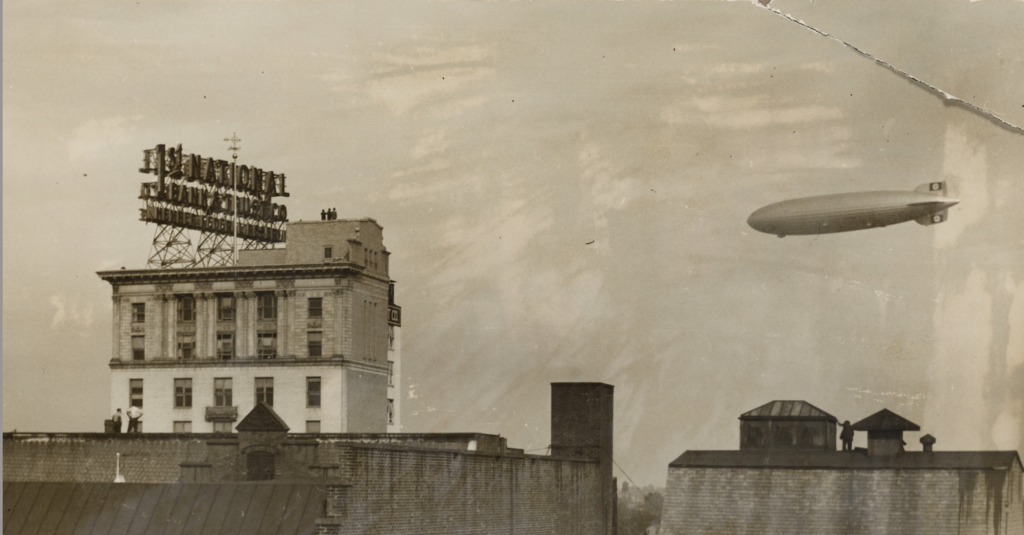
The Hindenburg flying over Bridgeport, October 1936. Bridgeport History Center, Bridgeport Public Library
By Carolyn Ivanoff
(c) Connecticut Explored Inc. Summer 2022
Subscribe/Buy the Issue!
In the early years of flight, zeppelins were massive, rigid-framed, fabric-covered airships that captured the world’s imagination. Named for German Count Ferdinand von Zeppelin, who invented them in the late 1890s, these fascinating “lighter than air” ships had hollow, tubular bodies pumped full of hydrogen. The Germans had used zeppelins to bomb England during World War I, but by the 1930s zeppelins were being introduced as luxury transatlantic passenger liners.
One of my father’s favorite stories about growing up on Bridgeport’s East Side was the day in 1936 that the Hindenburgflew over St. Mary’s School. He told me that the nuns let all the students out of school to see it cruising above the city. It was a vivid and unforgettable memory for him.
I hadn’t thought about this story for a long while until I was researching a project using the Bridgeport History Center’s digital collections. I happened upon a photograph of a zeppelin flying over Bridgeport. I immediately thought of my father, who would have been nine years old at the time. When I saw the photograph, his childhood story became real to me.
The Hartford Courant reported on May 10, 1936 about the Hindenburg’s maiden voyage to the U.S.—the first of 10 planned round trips to test the feasibility of a regular commercial route—with 51 passengers (including 15 Americans), freight, mail, and a crew of 56. It made the passage from Germany in 60 hours and 15 minutes.
That October the Hindenburg made its 10th and final trip for the year. On October 8,1936 the Hindenburg flew along the eastern U.S. coastline on its way to its destination in New Jersey. According to Bridgeport’s History Center’s Mary Witkowski in a 1996 Bridgeport News story, as it flew over Bridgeport, the aircraft’s commander radioed to Bridgeport Mayor Jasper McLevy, “… Felicitations to Bridgeport on 100th anniversary of city. Your industrial progress over century brings international note to your community. Best wishes continued success as one of foremost American municipalities.”
An estimated 150,000 people watched from Bridgeport’s streets and rooftops as the enormous Hindenburg circled the city twice. Factory whistles shrieked, people shouted and clapped, and the noisy atmosphere was festive as the massive airship sailed over the city. Bridgeport was one of the foremost American manufacturers of armaments, and in a few years many of the factories that blew their whistles, and the workers who turned out to cheer the huge German craft, would become crucial in manufacturing the weapons, arms, and ammunition that ultimately defeated the Nazi menace.
The Meriden Daily Journal reported on October 8, 1936 that the next day the Hindenburg would take U.S. oil executives on a 10-hour flight over six states. It passed over Danbury, Waterbury, New Britain, and Hartford before heading back to New Jersey for its return trip to Germany.
The following May, The Hartford Courant ran several articles about the devastating explosion of the Hindenburg while docking in New Jersey on May 6, 1937. It noted that the airship was longer than three football fields, the largest aircraft ever constructed and longer than the ocean liner Queen Mary. It was buoyed by 7.2 million cubic feet of hydrogen gas and traveled 84 miles per hour. The Hindenburg could carry a cargo of 20 tons and 70 passengers in its elegant cabin, which included a sophisticated dining room, a promenade deck, sleeping cabins, a bar, and a piano lounge.
The disaster ended commercial air travel by zeppelin forever. Radio and press worldwide reported that as the ship was docking at 7:21 p.m., two explosions rocked it. The highly flammable hydrogen that filled the craft mixed with oxygen and combusted in seconds, engulfing the Hindenburg in a ball of fire. Thirty-five passengers and a ground-crew member were killed. Miraculously, 62 passengers survived.
I’m more grateful than I can say for the Bridgeport History Center and its preservation mission. Through its archives, I am able to see in 2022 what my father saw in 1936—eight years before he joined the navy and served overseas in World War II—and to remember fondly the stories he told of growing up in Bridgeport.
Carolyn Ivanoff is a retired high school administrator and independent historian. She last wrote “Bridgeport’s Monumental Bronze Company,” Spring 2022. Her book We Fought at Gettysburg (Gettysburg Publishing, 2022) features first-hand accounts by the survivors of the 17th Connecticut Infantry.
Explore!
Bridgeport in World War II: “A Sound They’ll Never Forget,” Fall 2022
Grating the Nutmeg episode 147: The Hindenburg Flies Over Connecticut with historian Alexander Rose, author of Empires of the Sky, Zeppelins, Airplanes, and Two Men’s Epic Duel to Rule the World (Random House, 2020) and Bridgeport historian Carolyn Ivanoff, author of “The Hindenburg Flies over Bridgeport” in the Summer 2022 issue.
GO TO NEXT STORY
GO BACK TO SUMMER 2022 CONTENTS
